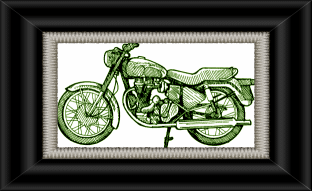| Home > Articles > Motorcycle History 101 |
Motorcycle History 101
Invention of the Motorcycle
Jennifer Rails (August 2022)When looking at today's motorcycles one might wonder exactly when the history of these amazing machines began. There is no simple answer to the question.
 The modern motorcycle is actually a combination of three inventions; the bicycle, the engine and rubber tires. Without all three components, there could be nothing that resembles a motorcycle, but each of the three ideas was conceived during vastly independent time periods then eventually combined to create the marvelously simple and graceful mobility machine now enjoyed by millions all over the world.
The modern motorcycle is actually a combination of three inventions; the bicycle, the engine and rubber tires. Without all three components, there could be nothing that resembles a motorcycle, but each of the three ideas was conceived during vastly independent time periods then eventually combined to create the marvelously simple and graceful mobility machine now enjoyed by millions all over the world.
The Tire
We know that the wheel was invented sometime around 3500 BC, but early wheels were made of stone, or wood, and hence had virtually no traction. They were designed to be pulled, not driven. Since a driven wheel is such an essential component of a motorcycle, we'll have to consider the invention of the tire an essential predecessor to invention of the motorcycle. This didn't happen until the year 1839 when Charles Goodyear found a way to keep rubber in a solid state. Rubber in its natural state is very sticky during hot weather and contracts a great deal when cooled, so was it was largely unusable for tires before Goodyear discovered his special procedure.
Tires were solid rubber until Robert William Thomson invented the first pneumatic wheel in 1845, but due to manufacturing costs the product failed. About fifty years passed until 1888 when a Scottish veterinarian named John Boyd Dunlop developed the first practical pneumatic tire for his son's tricycle. We'll consider that the first actual tire.
The Engine
As you may have guessed, the first motorcycles were operated by steam engines, and the first steam engine can be traced back to Greek engineer Heron of Alexandria sometime before 300 BC. Of course many engineers and inventors since then have experimented with steam engines, but in 1769 the Scottish inventor James Watt developed one of the first practical steam engines by improving the Newcomen engine design. (Some sources contend that the Newcomen engine was the first true steam engine, but there are even earlier examples such as the one made by Thomas Savery in 1679). Moving forward to 1867, the German designed Otto-Langen atmosphere engine was developed and about five years later with the help of Gottlieb Daimler and Wilhelm Maybach they designed the first four-stroke engine. These revolutionary engines looked like this.
The Bicycle
The history of the bicycle itself is also somewhat debatable, but many historians point to the German Baron von Drais who, in 1817, built a type of "walking machine" that, had two large wheels, a front steering wheel, and a frame that you could hop on. The odd contraption did not have foot pedals, but rather a mechanism whereby the operator woud have to push with their feet on the ground get going.
The next major improvement that was made in 1865 when foot pedals were added directly to the large front wheel of the bicycle. Known as the velocipede, which in French means “fast foot”, this form of the bicycle continued to evolve to the common, everyday form of transportation that we see today. (For more information about the history of the bicycle, try the International Bicycle Fund.
Putting It All Together
While there may be some dispute over when the actual first motorcycle was assembled, it is certain that the 19th century was the century in which the earliest motorcycles were being developed.
Some argue that the first motorcycle was built by American inventor Sylvester Howard Roper, who built a two-cylinder steam powered version 867. This machine was credited with achieving speeds up to 36 mph. Unfortunately Sylvester Roper died of a heart attack while trying to break his own speed record while showing off his machine at a state fair (he did break the record at 40mph!). Knowing that, you could say this guy certainly qualifies as one of the first “motorcyclists”! Check out this picture of that history-making machine.
At roughly the same time that the Roper was enjoying his short lived freestyle MX career, French brothers Ernest and Henri Michaux were working with their father Pierre to put a Perreaux steam-powered engine on a velocipede bicycle, and in 1868 they named their new invention the Michaux - Perreaux Steam Velocipede. (meh!)
Some also argue that the credit could go Gottlieb Daimler, a German automotive engineer who placed a one-cylinder 264cc Otto-cycle engine on a wooden bicycle with the wheels made of iron with wooden spokes (!!). His engineering partner Wilhelm Maybach test rode the vehicle for about 2 miles, but with the iron wheels, it only achieved about 7.5 mph. Hardly a 'factory ride', but notable.
The first motorcycle to actually resemble today's machines was the Millet Motorcycle, built by Frenchman Felix Millet in 1892. This machine had pneumatic tires and a five-cylinder rotary engine built directly into the rear wheel.






